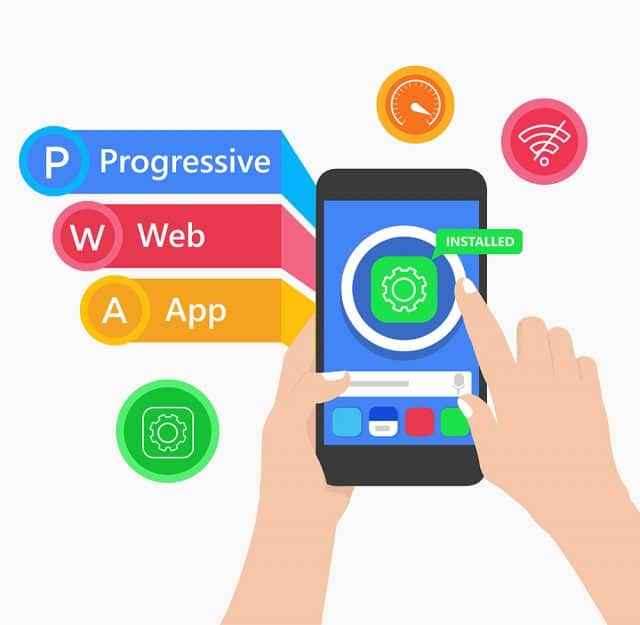7 reasons to make your website a progressive web app

These days progressive web applications (PWAs) are gaining their share in the web world. They have become a decent alternative to native mobile applications. There is even an opinion that progressive web apps have enough potential to become the future of the web.
In this article, we will discuss the core benefits of this advanced technology. You will find out what makes PWAs so special and why you should consider turning your website into a progressive web app.
1. Cost-effectiveness and reduced development time
When building a web and native application, you will have to hire three separate development teams for each solution. These specialists will create the web-based solution, and Android and iOS versions. This way, the mobile app development process is getting time-consuming and costly.
PWAs are essentially web applications. Given that, you will need only one team to create a single solution. Consequently, this means reduced time and cost expenses as compared to creating a native mobile app.
2. PWAs are fast-loading and light
It is a well-known fact that your website should take no longer than 3 seconds to load. Otherwise, you may lose customers. PWA technology prevents this problem. Service Workers take care of that, caching all the required data. As a result, fast loading increases user satisfaction significantly.
Also, it should be noted that PWAs are smaller in size than native mobile apps. There is no need to download an ARK file that can take 40 MB or even more if we talk about games.
3. Improved visibility in search results
All businesses without any exception want to get on the first page of Google. High ranking means increased traffic and desired conversions.
In 2018, Google rolled out mobile-first indexing. After its launch, mobile-friendly and fast-loading websites became a top priority for the internet giant. That’s when advanced progressive web applications can save the day.
Since PWAs are basically mobile-friendly websites, search engines can easily crawl all the content of a PWA. In contrast, when it comes to native applications, only the app's profile page is visible in Google search results.
4. Increased conversion rates
You may be surprised, but progressive web apps can become excellent tools to boost sales. It’s no coincidence that famous brands such as Flipkart, OLX, Alibaba, Pinterest, and Forbes turned their websites into PWAs. This way, businesses managed to achieve great results in terms of conversions and user engagement.
The thing is that PWAs can send users push notifications, like native mobile apps. With their help, brands can inform their customers about new offerings, discounts, or special deals.
Also, when added, a PWA appears on a users’ home screen and stays there. This way, they draw more users’ attention. It is getting easier for customers to return to the website to interact with their favorite brands.
5. Offline mode
Built-in Service Workers pre-cache all the data automatically. Owing to this technology, there is no need to download the important features and info. As a result, users can browse the pages even without an Internet connection.
Along with that, if Service Workers didn’t finish caching, the website won’t show users a dinosaur. Instead, they will see a customized offline message.
6. Independence from app store
As soon as mobile applications are launched, developers need to add them to major stores where users can find and download them.
Google Play, App Store, and Microsoft Store tend to set strict requirements for the software that will be added to their database. Meeting all those requirements can become a costly, tedious, and time-consuming challenge.
PWAs being web applications, are not necessarily added to app stores. Users can find them on Google like any other website and add them to the home screen of their devices.
7. Easy to install and update
As we have said before, users do not need to download progressive web apps. Instead, they open PWAs in a browser and when they see the pop-up prompt, they allow “Add to the home screen”. In some cases, users have to open their browser menu and use the Add to home screen option.
Both these options differ from a multi-level installation of a native mobile app, where users have to find an app in the App Store amidst 2 million of others, download and install it.
Speaking of updating a PWA, developers don’t need to roll out updates according to new versions of OSs. As your PWA belongs to the web in any case, users will always have access to the latest version.
Final thoughts
As you can see, PWA technology holds promises to replace native applications and become the future of the web. It brings business multiple benefits from cost reduction to increased conversion rate.
I hope that the reasons discussed in this article will convince you to invest in building progressive web applications.
Photo credit: Prabowo96/ Shutterstock

Dmitry Chekalin is CEO at Codica. Software Entrepreneur with 15+ years of experience. Focused on the lean startup approach. He writes about startups, marketplaces and SaaS products, and custom software development. Connect with him at Twitter | Linkedin | Facebook.